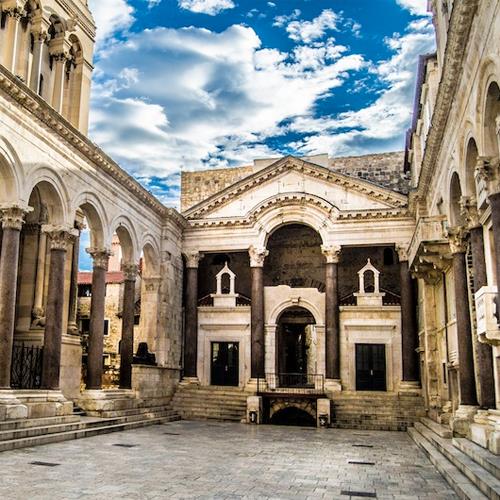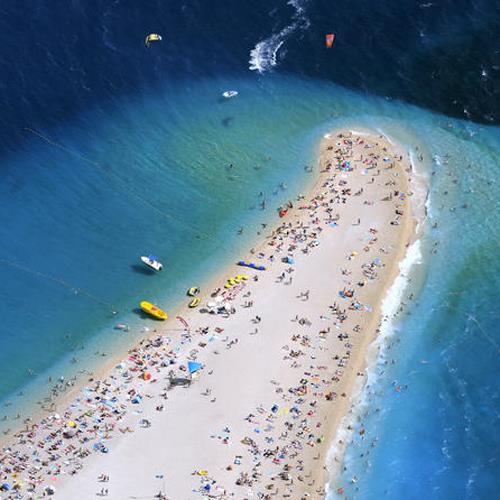Day 1 in Split
Welcome to Croatia! Upon arrival, you will go through customs and immigration. Should you opt to purchase a transfer to your hotel; a representative will be waiting for you as you exit immigration. Make your way to Split and arrive at your hotel. Check in and do not give in to jet lag! There is so much for you to see and do!
The showcase attraction in Croatia`s second-largest city is Diocletian`s Palace. It is the most expansive and best-preserved example of a Roman-era palace left in the world today. Diocletian`s Palace was built between the years of 295 and 305 CE. The Roman emperor Diocletian was from the town of Salona (modern-day Solin), the capital of the Roman province of Dalmatia, located about four miles northeast of the site where his palace was eventually built.
Diocletian abdicated the throne on May 1 in the year 305 CE, and he stepped through Golden Gate to start his retirement on June 1. When he died six years later, he was interred in the mausoleum which is now part of St. Domnius Cathedral, dedicated to the patron saint of Split who lived during the time of Diocletian. The noteworthy bell tower, which is nearly 200 feet tall, is a stellar example of Dalmatian Romanesque religious architecture.
The main square inside Diocletian`s Palace is called Peristyle. While in the square, you will see a Sphinx, which is the only surviving granite statue out of twelve given to Diocletian by the Egyptians. The gate to the west of the Peristyle is called Iron Gate; the gate to the east of the Peristyle is called Silver Gate. These gates connect Diocletian`s Palace to the outside fringes of the Old Town. If you head west, toward Iron Gate, you can see the shrine dedicated to Jupiter that was built at Diocletian`s behest. If you head south, in the direction of Riva, from Peristyle, you will first enter the Vestibule, which is where emissaries were received before gaining full access to the palace. The southern part of the palace grounds include Diocletian`s Palace cellars, which is a reproduction of the living quarters as they would have looked in the fourth century CE. Similar historic reproductions can be found at the Split Ethnographic Museum adjacent to the cellars.
Make your way to Fruit Square and grab yourself a snack from any one of the cafes lining the perimeter. From there, visit the Venetian Tower, the only remnant left of the Middle Ages-era Venetian castle meant to protect Diocletian`s Palace. Wind the day down and stroll the waterfront road, Riva, having dinner at one of the restaurants or cafes along the way. Find Brass Gate, accessible from Riva; once you have found it, you have seen all four original entrances to Diocletian`s Palace. Return to your accommodations at the end of the evening.




Day 2 in Split
Wake up bright and early and explore Marjan Forest Park, which is located about two miles to the west of the Old Town. If you prefer, walk Riva down from the Old Town to ACI Marina Split, where yacht charters and private yachts dock, and Sustipan, a park and green space built on the site of an old monastery. Hike up to the top of Marjan Hill and experience the breathtaking views of Split and the Adriatic Sea below. Afterwards, you can head back down the hill and view the life`s works of Ivan Mestrovic, the father of modern Croatian sculpture, at the Mestrovic Gallery, located south of the hill. If you want some beach time instead, there are two beaches to choose from in Marjan Forest Park: Bene Beach, on the northern side of the park, and Kasjuni Beach, on the southern side.
Head back in the direction of the Old Town via Riva and, if you have the chance, take a look around the Church and Monastery of St. Francis, which is home to thousands of religious artifacts dating back hundreds of years. Stroll two of the major squares in Split`s Old Town: Republic Square, modeled after St. Mark`s Square in Venice; and People`s Square, where you can stop for lunch at one of the cafes or restaurants. While in People`s Square, stop at the Old Town Hall, which has a beautiful Venetian-style loggia. After lunch, stroll Strossmayer Park, on the northern end of Diocletian`s Palace, where there are the remnants of the Chapel of St. Arnir and a statue of Gregory of Nin, the man who is credited with making Croatians predominantly Catholic by leading the first Masses in the Croatian language. Finish the day by enjoying a rare example of Modernist religious architecture by stopping by the Church of Our Lady of Good Health. Return to your accommodations at the end of the day.



Day 3 in Split
Many of us want to be `one with nature`, and Split offers many chances to experience the great outdoors. North of town, there are two cordilleras called Kozjak and Mosor, and their peaks are the highest points of elevation in Split and environs. There are very popular hiking trails in both places. If you like, choose one to hike. If you choose Kozjak, at the end of the cordillera, there is a cliffside fortress called Klis Fortress which was the home base for many generations of Croatian dukes and kings. On the way back into town, you will drive past the Diocletian Aqueduct, which brought water from a fresh water source inland directly to Diocletian`s Palace. If you`d like to know more about the seafaring traditions of Split, visit the Croatian Maritime Museum, located inside Gripe Fortress. Afterward, spend the rest of the day either at Bacvice Beach, the most popular beach in Split and the only sandy option in the area, or the quieter Znjan Beach. Party at one of the nightclubs in Bacvice before returning to your hotel or rental at the end of the evening.


Additional Days in Split
Consider taking a catamaran to Brac Island, 21 miles southeast of Split. The largest town on Brac Island is Supetar, named for St. Peter, which is also the namesake of the parish church and town square. Bol, on the western side of the island, is another sizable resort town, located just two miles from some of the most coveted holiday shoreline in Croatia, the Zlatni Rat, or the `Golden Cape`. Take time to explore the impressive stone facades of the village of Pucisca, the products of generations of stonemason expertise.
Split also offers direct catamaran service to Solta Island, 12 miles to the southwest. Solta, an island with a population of 1,700, is very sleepy, and many residents still work on fishing boats and in vineyards. The main port which will be your point of arrival is Rogac, and the largest fishing town is Maslinica. The oldest village on the island is called Grohote, and buildings here are hundreds of years old and built completely out of stone.
Finally, head further south on the catamaran and make a stop at Hvar Island, one of the top ten island vacation destinations in the world according to Conde Nast Traveler Magazine. Imagine beautiful fields of Croatian lavender and rolling green hills and you would be imagining the Stari Grad Plain, a UNESCO World Heritage Site. The plain sits between two sizable towns, Stari Grad and Jelsa, which are full of history and charm. The largest town, Hvar Town, sits on the southwest coast. The fully-pedestrianized city center buzzes with activity both day and night as a city known equally for its history and its heady nightlife.


Your Last Day in Split
Depart your hotel and head to the airport for your return home. We recommend that you purchase a private transfer; if so, a representative will meet you at the hotel in time to take you to the airport for your flight out. We hope you enjoyed the noteworthy sights of historic Split!
